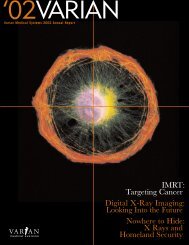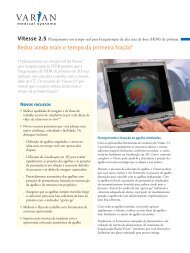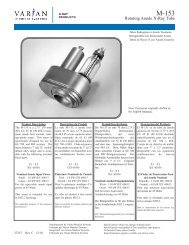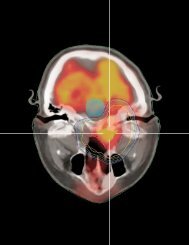Varian Linatron High-Energy X-ray Applications 2007
Varian Linatron High-Energy X-ray Applications 2007
Varian Linatron High-Energy X-ray Applications 2007
You also want an ePaper? Increase the reach of your titles
YUMPU automatically turns print PDFs into web optimized ePapers that Google loves.
Glossary<br />
ABSORPTION<br />
Process in which X-<strong>ray</strong> photons, as they pass through a<br />
material, are absorbed in the material. (See<br />
PHOTOELECTRIC ABSORPTION and PAIR<br />
PRODUCTION).<br />
ATTENUATION<br />
Combination of absorption and scattering processes in<br />
which X-<strong>ray</strong>s, as they pass through material, are either<br />
stopped, or diverted from straight and forward travel. Total<br />
Attenuation, depending upon the X-<strong>ray</strong> energy, consists of:<br />
PHOTOELECTRIC ABSORPTION, COMPTON<br />
SCATTERING and PAIR PRODUCTION.<br />
BACKSCATTER<br />
Secondary radiation produced by scattering of X-<strong>ray</strong>s from<br />
their original (forward) direction through angles greater<br />
than 90 degrees.<br />
BEAM FLATTENER<br />
Cone shaped X-<strong>ray</strong> absorber placed centrally in the beam<br />
of a high-energy X-<strong>ray</strong> source, to absorb a relatively greater<br />
proportion of the high-intensity central <strong>ray</strong>s than of the<br />
<strong>ray</strong>s at the edges of the beam, to produce a more uniform<br />
X-<strong>ray</strong> intensity at the plane of the X-<strong>ray</strong> film. Also referred<br />
to as a BEAM COMPENSATOR.<br />
BEAMING<br />
The condition that higher radiation intensity occurs in the<br />
forward, central X-<strong>ray</strong>s from a high-energy X-<strong>ray</strong> source<br />
(target) than is emitted in all other directions. Caused by<br />
the large forward momentum of the accelerated electrons<br />
which strike the target to produce the X-<strong>ray</strong>s.<br />
BLOCKING<br />
Use of lead or other shielding material around the edges of<br />
the object being radiographed, to absorb scattered<br />
radiation that would otherwise expose and excessively<br />
darken areas of the X-<strong>ray</strong> film under the object.<br />
page 59<br />
BROAD BEAM<br />
Arrangement of the source, object and x-<strong>ray</strong> film (or other<br />
radiation detector) in which scattered radiation from the<br />
object contributes to the total exposure (at a given point)<br />
on the film; specifically, scattered radiation at solid angles<br />
greater than 0.01 steradian. The solid angle is formed by<br />
the point on the film and the perimeter of the exposed<br />
cross- sectioned area of the object. NARROW BEAM<br />
arrangements are those where scatter reaching the x-<strong>ray</strong><br />
film or detector is only that scatter radiation within angles<br />
less than 0.01 steradian.<br />
CENTRAL RAY<br />
Line within the x-<strong>ray</strong> beam, coincident with the direction<br />
of peak x-<strong>ray</strong> intensity, the (usually) central axis of the<br />
electron accelerator, and with the axis of the collimator. (It<br />
also coincides with the laser beam indicator in a <strong>Linatron</strong>.)<br />
COLLIMATOR<br />
<strong>High</strong>-density metal absorber with a conical (sometimes<br />
pyramid-shaped) opening for passage of x-<strong>ray</strong>s to produce<br />
a well-defined beam of x-<strong>ray</strong>s from the target.<br />
COMPENSATOR<br />
(See BEAM FLATTENER)<br />
COMPTON SCATIERING<br />
X-<strong>ray</strong> attenuation process in which a photon transfers<br />
energy and momentum to an orbital electron of the<br />
attenuating material, and continues to travel through the<br />
material at an angle to the original photon direction.<br />
CONTRAST<br />
RADIOGRAPHIC CONTRAST is the magnitude of the<br />
difference in density from one area to another on a<br />
radiograph resulting from variation in x-<strong>ray</strong> intensity<br />
transmitted through the corresponding sections<br />
(thicknesses) of the object being radiographed. SUBJECT<br />
CONTRAST refers to the ratio of radiation intensities<br />
transmitted through selected sections of the object, and is<br />
therefore a function of the thicknesses of those sections.<br />
(Also see: FILM CONTRAST)<br />
<strong>Varian</strong> <strong>Linatron</strong> applications


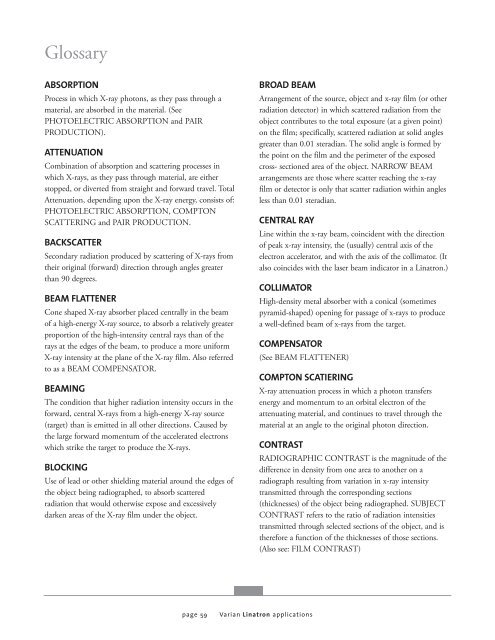







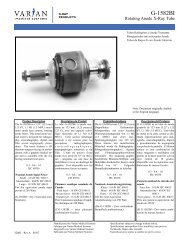
![[MSDS 126] Dow Corning 200 Fluid, 5 CST Part Number ... - Varian](https://img.yumpu.com/5104917/1/190x245/msds-126-dow-corning-200-fluid-5-cst-part-number-varian.jpg?quality=85)

